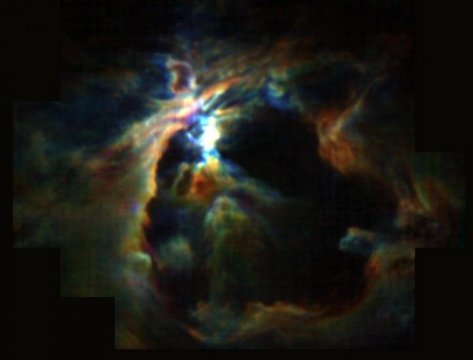[ad_1]
The stellar wind from a newborn star in the Orion Nebula prevents more new stars from forming nearby. That is the result of new research conducted by an international research team led by the University of Cologne (Germany) in the Collaborative Research Centre ‘Conditions and Impact of Star Formation — Astrophysics, Instrumentation and Laboratory Research’, and the University of Leiden (Netherlands) using NASA’s Stratospheric Observatory for Infrared Astronomy, SOFIA.
The result is surprising because until now, scientists thought that other processes, such as exploding stars (supernovae), were largely responsible for regulating the formation of stars. But SOFIA’s observations suggest that infant stars generate stellar winds that can blow away the seed material required to form new stars, a process called ‘feedback’. The paper, ‘Disruption of the Orion Molecular Core 1 by the stellar wind of the massive star θ1 Ori C’, has now been published in Nature.
The Orion Nebula is among the best observed and most photographed objects in the night sky. It is the closest stellar nursery to Earth, and helps scientists explore how stars form. A veil of gas and dust makes this nebula extremely beautiful, but also shrouds the entire process of star birth from view. Fortunately, infrared light can pierce through this cloudy veil, allowing specialized observatories like SOFIA to reveal many of the star-formation secrets that would otherwise remain hidden.
At the heart of the nebula lies a small grouping of young, massive and luminous stars. Observations from SOFIA’s instrument, the German Receiver for Astronomy at Terahertz Frequencies, known as GREAT, revealed, for the first time, that the strong stellar wind from the brightest of these baby stars, designated Theta1 Orionis C (θ1 Ori C), has swept up a large shell of material from the cloud where this star formed, like a snow plow clearing a street by pushing snow to the road’s edges.
‘The wind is responsible for blowing an enormous bubble around the central stars’, explained Cornelia Pabst, a doctoral researcher at the University of Leiden and lead author of the paper. ‘It disrupts the natal cloud and prevents the birth of new stars.’
Researchers used the GREAT instrument on SOFIA to measure the spectral line — which is like a chemical fingerprint — of ionized carbon. Because of SOFIA’s airborne location, flying above 99 percent of the water vapour in the Earth’s atmosphere that blocks infrared light, the researchers were able to study the physical properties of the stellar wind.
‘The large-scale Orion C+ observation demonstrates that such scale mapping is possible with SOFIA/upGREAT. The multi-pixel SOFIA/upGREAT receiver allows us to map larger regions in a shorter time compared to previous instruments. It is about 80 times faster than the single pixel HIFI receiver onboard the ESA cornerstone mission Herschel’, says Ronan Higgins, who led the investigation from the University of Cologne’s side.
Similarly, the astronomers use the ionized carbon’s spectral signature to determine the speed of the gas at all positions across the nebula and study the interactions between massive stars and the clouds where they were born. The signal is so strong that it reveals critical details and nuances of the stellar nurseries that are otherwise hidden. But this signal can only be detected with specialized instruments — like GREAT — that can study far-infrared light.
At the center of the Orion Nebula, the stellar wind from θ1 Ori C forms a bubble and disrupts star birth in its neighbourhood. At the same time, it pushes molecular gas to the edges of the bubble, creating new regions of dense material where future stars might form.
These feedback effects regulate the physical conditions of the nebula, influence the star formation activity and ultimately drive the evolution of the interstellar medium, the space between stars filled with gas and dust. Understanding how star formation interacts with the interstellar medium is key to understanding the origins of the stars we see today, and those that may form in the future.
Story Source:
Materials provided by University of Cologne. Note: Content may be edited for style and length.
[ad_2]















